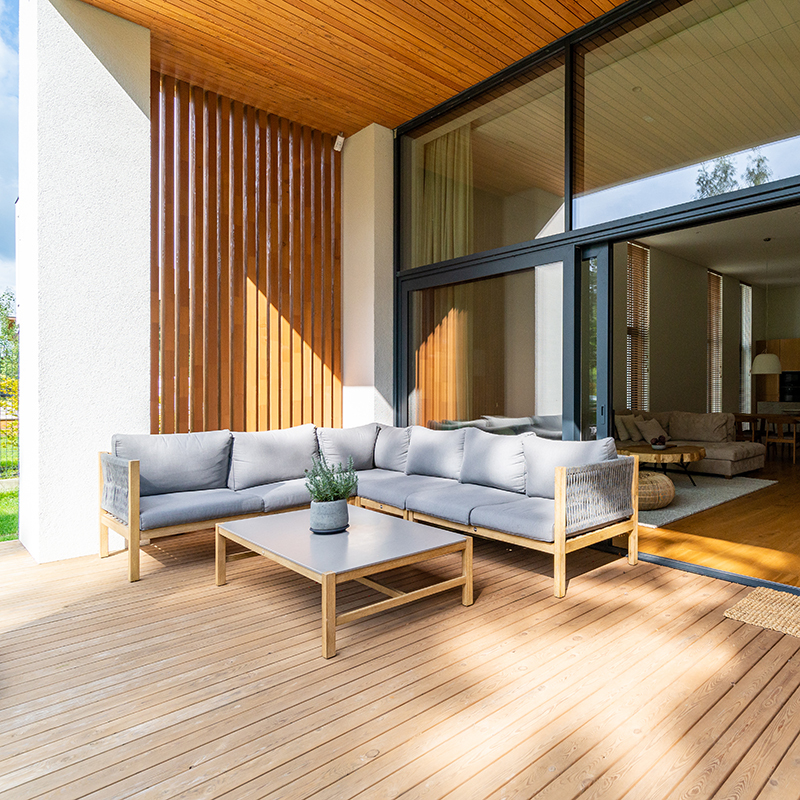
With the internet at your fingertips, it’s easy to scroll through thousands of reviews to see if a product is worth your while, rather than just bring it home and try it out for yourself. But we here at NJ HOME love to make your home shopping easier—especially when considering materials for a new or revamped deck. Below, we lay out the differences between the most common types of materials available so you can make an informed decision about what works best for you and your home. No buyer’s remorse here.
Of course, you’ll need a professional to install or build the deck for you (unless you’re super handy, then by all means), but here’s your Deck Guide 101, if you will, so you know the basics and what questions to ask as you get started on your dream deck project.
Aluminum decking
Pro: Aluminum is a low-maintenance, durable decking option that won’t rot, be infested with mold or be prone to insects. It also won’t get as hot underfoot as some of its competitors, and comes in many different styles to fit your aesthetic.
Con: The linear look of aluminum isn’t for everyone. But the biggest downside perhaps is its sound. You’re likely to hear ‘pings’ when you walk on it or when it’s struck by rain.
Price: About $12-$15 per square foot
Cedar and redwood decking
Pro: Wood is one of the OG decking materials; many decks in our area are made from cedar. According to Sherwood Lumber, with locations in Linden, Elizabeth, Edison and Delanco, cedar is the most popular type of decking used in New Jersey because it can withstand all four seasons. It’s a strong, high-quality wood that’s rot-resistant as well, plus, it has a natural color to it, which means it looks pretty. Redwood is also naturally resistant to decay, and it’s one of the most sustainable building materials on the market.
Con: Cedar decks can require a lot of maintenance—if you go this route, expect to stain and paint it regularly. However, if you choose to seal your cedar deck, which will protect it from the sun and other natural elements, you’ll prolong its life and not have as much upkeep. Redwood also requires a stain every few years to help maintain its hue.
Price: An average of $20-$75 per square foot for cedar, and about $30-$75 per square foot for redwood

Composite decking
Pro: As the name suggests, composite decking is made of different materials that combine to create a new product. Many are made of low-density polyethylene (LDPE) plastic and wood fibers, but there are other combinations to consider too as well as tons of styles to choose from. Composite decking can be made to look like real wood, but it’s a less expensive alternative to the real thing.
Con: Because composite decking boards are not as strong as real wood, you’ll need to have your pros install an understructure to keep it from sagging. It also tends to get very hot in the summer, and the material is not as resistant to mold and insects as some of the other options are.
Price: $5-$13 per square foot (just for the boards)
Luxury wood decking
Pro: Luxury woods such as ipe (pronounced e-pay), teak and tigerwood are gorgeous thanks to their naturally brown or reddish tones. Tigerwood has a natural stripe pattern, which gives it its name. These types of wood are very durable too, and can last for many years.
Con: Because these luxury woods are darker in hue, they’re hotter in the summer than some other decking options. They also require upkeep and maintenance, such as staining or oiling, to retain their natural colors. But cost is perhaps the biggest downside of these pretty pieces.
Price: Ipe goes for about $25-$65 per square foot, while you’ll find Redwood for about $30-$75 per square foot. Teak can cost anywhere from $7-$41 per square foot, since it’s one of the most popular hardwoods and, as a result, is the most difficult to source. Tigerwood will run you about $13-$50 per square foot.
Pressure-treated lumber decking
Pro: This type of wood is a low-maintenance option, and it’s one of the strongest too. Pressure-treated decks have a long life expectancy given how protected they are from the mold, rain and bugs. You can stain it too to give it a different appearance if you so desire. Consumers should also be aware of the lumber’s pressure grade level: The higher grades have fewer defects like splits and knots and are, in general, easier to maintain.
Con: This wood is treated with chemicals to keep insects away, prevent rotting and withstand the weather. If you take any power tools to it, or need to do any work, you’ll need to wear masks and protective gear to avoid the fumes as much as possible.
Price: An average of $15-$25 per square foot, depending on the grade
PVC decking
Pro: Polyvinyl chloride (PVC) plastics are virtually maintenance free—you won’t have to worry about decay, bad weather or the like if you go this route. It’s also a great option if you prefer a more contemporary look, because PVC comes in brown, gray, white, tan and wood-grain options, among other colorways.
Con: PVC is the least environmentally friendly of the materials on this list as it’s made of 100 percent plastic, so it’s not the way to go if you’re trying to limit your carbon footprint (though it can be recycled once it’s lived its life!).
Price: An average of $10-$15 per square foot
What material are you considering for your deck? Let us know (and give us a follow!) on Instagram @njhomemag. For more expert home advice, grab your copy of the brand-new summer 2023 issue of NJ HOME, out now.